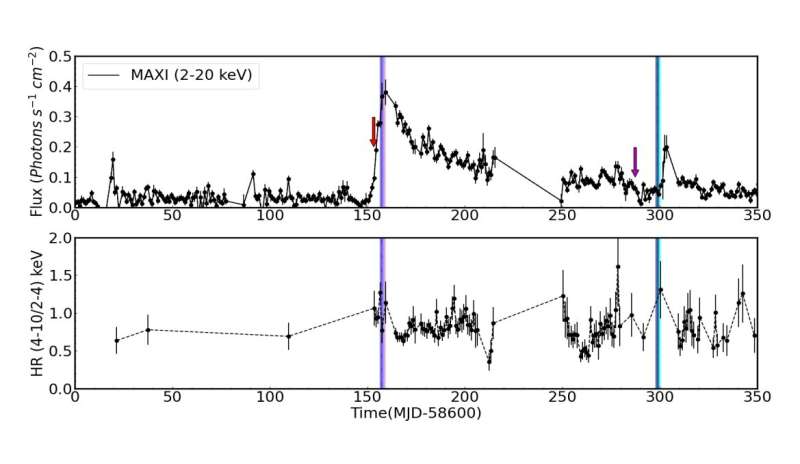March 30, 2023 report
This article has been reviewed according to Science X's editorial process and policies. Editors have highlighted the following attributes while ensuring the content's credibility:
fact-checked
preprint
trusted source
proofread
Astronomers observe X-ray binary XTE J1739−285 during recent outbursts

Using AstroSat and NuSTAR space telescopes, astronomers have observed an X-ray binary known as XTE J1739−285 during its recent period of bursting activity. Results of the observational campaign, published March 23 on the arXiv pre-print server, yield crucial insights into the behavior of this system.
X-ray binaries (XRBs) consist of a normal star or a white dwarf transferring mass onto a compact neutron star or a black hole. Based on the mass of the companion star, astronomers divide them into low-mass X-ray binaries (LMXB) and high-mass X-ray binaries (HMXB).
Some LMXBs exhibit transient outbursts, during which an increase in X-ray luminosities is observed. When these outbursts are characterized as Type I X-ray bursts—thermonuclear explosions taking place on the surface layers of neutron stars—they obviously confirm the presence of neutron stars in such binaries.
Discovered in 1999 by the Rossi X-ray Timing Explorer (RXTE), XTE J1739−285 is a transient LMXB with a neutron star companion. Since its discovery, the source has experienced dozens of X-ray bursts. More recently, in 2019, it entered a rebrightening phase, during which new X-ray outbursts were identified.
A team of astronomers led by Aru Beri of Indian Institute of Science Education and Research (IISER) Mohali in India, started to observe XTE J1739−285 in October 2019, when the system was in its bursting period. They employed India's AstroSat and NASA's NuSTAR (Nuclear Spectroscopic Telescope Array) spacecraft to perform a detailed timing and spectral study of XTE J1739−285.
"In this paper, we report our results from AstroSat and NuSTAR observations of XTE J1739−285 during its 2019 and 2020 outbursts. We have performed a detailed timing and spectral study of this source," the researchers wrote.
The X-ray light curves during observations of XTE J1739−285 conducted in 2019 by Beri's team indicate the presence of flares. Moreover, the observations identified accretion-powered X-ray pulsations at 386 Hz during very short intervals (from 0.5 to 1 s) of these X-ray flares, which makes XTE J1739−285 an intermittent X-ray pulsar.
AstroSat observations of XTE J1739−285 in 2020 unveiled the presence of a thermonuclear X-ray burst, which led to the detection of coherent burst oscillations at 383 Hz during the burst's decay phase. Therefore, XTE J1739−285 turns out to be one of a few neutron star LMXBs experiencing both nuclear- and accretion-powered pulsations.
The observations also detected a quasi-periodic oscillation (QPO) at 0.83 Hz with root mean square (rms) variability of about 7% during the hard state of XTE J1739−285 in 2020. The astronomers noted that a similar feature was not found during the soft state of the source, in the preceding year. In addition, the X-ray spectroscopy revealed significant changes in the X-ray spectra of XTE J1739−28 during the 2019 and 2020 outburst.
More information: Aru Beri et al, AstroSat and NuSTAR observations of XTE J1739-285 during the 2019-2020 outburst, arXiv (2023). DOI: 10.48550/arxiv.2303.13085
Journal information: arXiv
© 2023 Science X Network





















